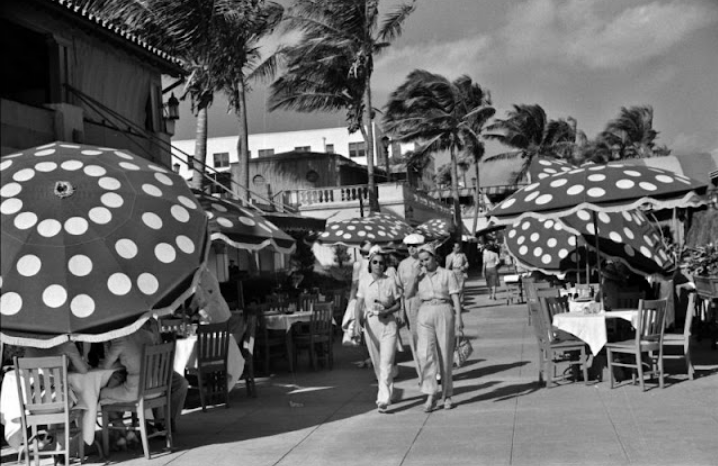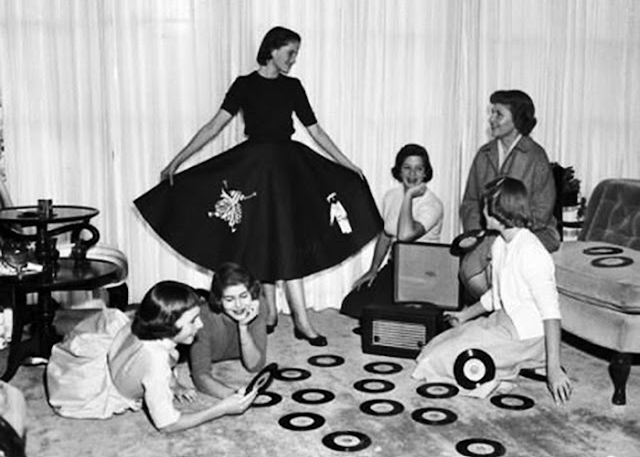As you cruise along the busy streets of any major American city, you can’t miss the countless signs of fast-food joints that decorate the skyline.
But before these drive-thrus became a common sight at every highway stop, these fast-food places started out like your local pizza place – with modest beginnings. In fact, the first-ever fast-food spots looked quite different from what you see today.
Many times, the founders who started these restaurants didn’t have much money, but they had big dreams. They took a chance and opened up what are now some of the most successful quick-service eateries in America.
Curious about how the iconic Golden Arches of McDonald’s looked before they transformed into symbols of prosperity? Ever wondered if White Castle ever actually resembled a fortress?
Curiosity piqued about how Taco Bell, with its distinctive Mexican-inspired flavors, came to be? Eager to catch a glimpse of Wendy’s, where the square patties reign supreme? Wondering if the familiar Domino’s logo has always adorned their storefronts?
So, if you’re ready to take a stroll down memory lane and uncover the origins of your favorite eateries, read on and indulge in a captivating journey into the past.
Arby’s (1964)
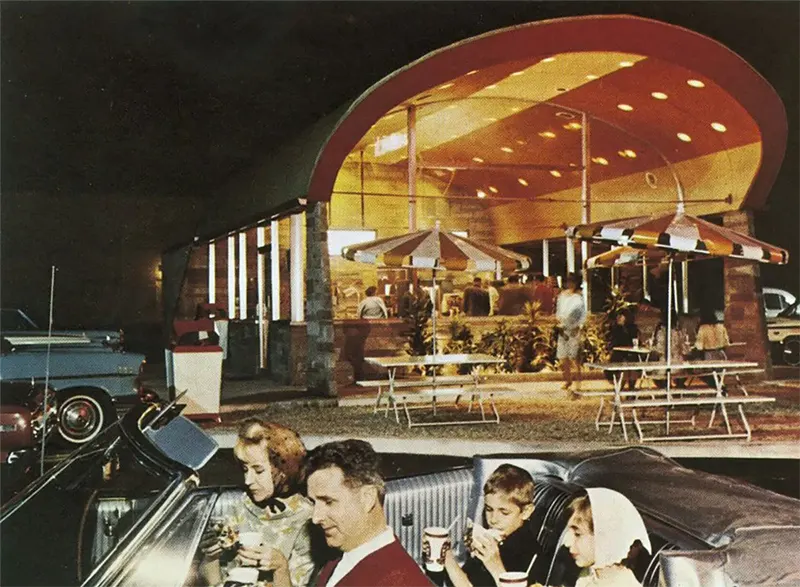
Arby’s (1964)
Arby’s was founded in Boardman, Ohio, on July 23, 1964, by brothers Forrest and Leroy Raffel, owners of a restaurant equipment business who thought there was a market opportunity for a fast food franchise based on a dish other than hamburgers.
They wanted to call their restaurants “Big Tex”, but that name was already used by an Akron business.
Instead, they chose the name “Arby’s,” based on R. B., the initials of Raffel Brothers; although often mistaken for Roast Beef.
The Raffel brothers opened the first new restaurant in Boardman, Ohio, just outside Youngstown, on July 23, 1964. They initially served only roast beef sandwiches, potato chips, and soft drinks.
Hoping to attract a more upscale clientele, Arby’s interior design was purposely more luxurious in appearance than the typical fast food sandwich stand of the day.
Blimpie (1964)

Blimpie (1964)
Founded by three friends, Tony Conza, Peter DeCarlo, and Angelo Baldassare, Blimpie introduced a new concept to the dining scene: the submarine sandwich, affectionately known as the “sub.”
With its distinctively elongated shape, inspired by the iconic airship, and a focus on fresh ingredients, Blimpie swiftly carved its niche.
It was founded in Hoboken, New Jersey, in 1964. The store’s name came about because Tony Conza preferred not to call the sandwiches subs, which he felt sounded like a greasy spoon.
Conza preferred the term hoagies, but Hoboken residents were unfamiliar with the Philadelphia term.
He scanned a dictionary until he found “Blimp”, a word that sounded to him most like a sandwich.
Bojangles (1977)

Bojangles (1977)
Founded by Jack Fulk and Richard Thomas, Bojangles opened its first location in Charlotte, North Carolina. The name “Bojangles” is an ode to a famous song from the 1920s, evoking a cheerful and memorable association.
From the start, the intention was clear—to offer more than just food; Bojangles aimed to provide an experience.
The restaurant quickly garnered attention for its unique offerings, centered around Southern classics. From the moment the doors opened, the aroma of freshly baked buttermilk biscuits filled the air.
These flaky, golden-brown delights soon became a hallmark of Bojangles, complemented by its tender fried chicken and flavorful fixings.
Burger King (1954)

Burger King (1954)
Burger King’s origins are tied to the partnership of Keith J. Kramer and Matthew Burns. Their venture was inspired by the belief that fast food could be elevated beyond the usual quick bites, aiming to provide a dining experience that felt more substantial and satisfying.
The name “Burger King” was a direct reflection of this aspiration—a nod to the perception of quality and royalty that the founders envisioned for their food.
Burger King’s menu has expanded from a basic offering of burgers, French fries, sodas, and milkshakes to a larger and more diverse set of products.
In 1957, the “Whopper” became the first major addition to the menu, and it has become Burger King’s signature product since.
Conversely, Burger King has introduced many products which failed to catch hold in the marketplace.
Some of these failures in the United States have seen success in foreign markets, where Burger King has also tailored its menu for regional tastes.
Chick-fil-A (1967)

In 1967, the first Chick-fil-A location opened in Atlanta, founded by Truett Cathy
The chain’s origin can be traced to the Dwarf Grill (now the Dwarf House), a restaurant opened by S. Truett Cathy, the chain’s former chairman and CEO, in 1946.
The name “Chick-fil-A” captures the essence of the menu’s primary offering: chicken. The “Chick” is a nod to the main ingredient, while the “fil-A” reflects the emphasis on quality and excellence.
The “A” signifies the restaurant’s commitment to providing the highest caliber of food and service.
During the 1970s and early 1980s, the chain expanded by opening new locations in suburban malls’ food courts.
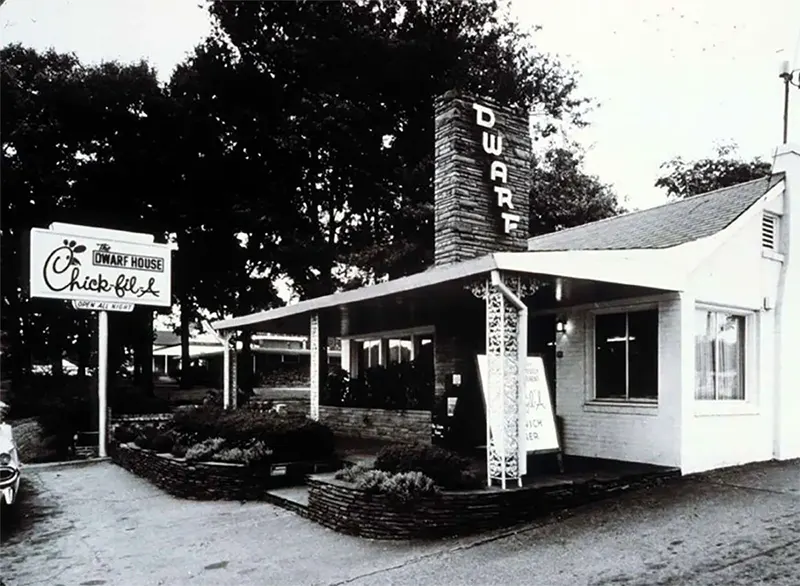
But before that, Cathy opened a diner called The Dwarf Grill in 1946, and it still serves Chick-fil-A classics today.
The first freestanding location was opened on April 16, 1986, on North Druid Hills Road in Atlanta, Georgia, and the company began to focus more on this stand-alone type unit rather than on the food court type.
Although it has expanded outward from its original geographic base, most new restaurants are located in Southern suburban areas.
Chipotle (1993)

Chipotle (1993)
Chipotle emerged onto the scene in 1993, bringing a fresh perspective to Mexican cuisine. Founded by Steve Ells, the restaurant’s name carries a subtle hint of its culinary approach and a commitment to quality.
“Chipotle,” pronounced chi-POHT-lay, is a term borrowed from the Nahuatl language, spoken by the Aztecs. It refers to a smoked, dried jalapeño pepper.
The first Chipotle restaurant, located in Denver, Colorado, introduced a novel concept: the assembly-line format.
Customers could customize their orders, selecting from a range of freshly prepared ingredients. This approach resonated with diners seeking a more personalized dining experience.
Domino’s (1960)
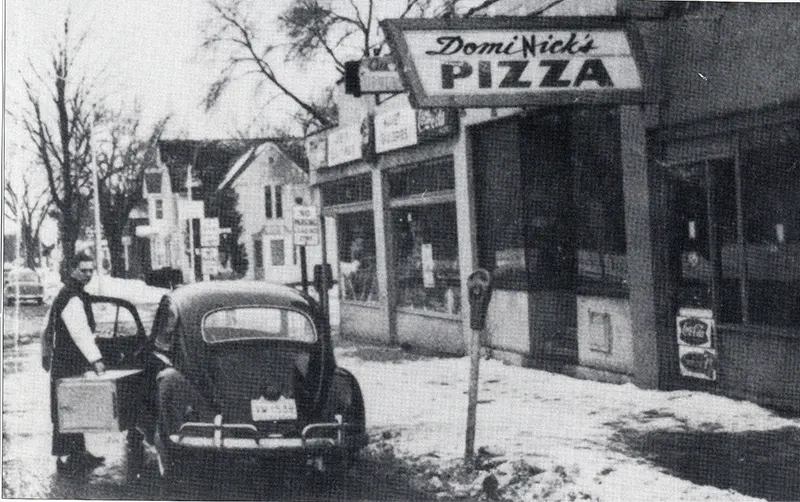
Domino’s (1960)
In 1960, Tom Monaghan and his brother, James, took over the operation of DomiNick’s, an existing location of a small pizza restaurant chain that had been owned by Dominick DeVarti, at 507 Cross Street (now 301 West Cross Street) in Ypsilanti, Michigan.
By 1965, Tom Monaghan had purchased two additional pizzerias; he now had a total of three locations in the same county.
Monaghan wanted the stores to share the same branding, but the original owner forbade him from using the DomiNick’s name.
One day, an employee, Jim Kennedy, returned from a pizza delivery and suggested the name “Domino’s”. Monaghan immediately loved the idea and officially renamed the business Domino’s Pizza, Inc. in 1965.
The company logo originally had three dots, representing the three stores in 1965. Monaghan planned to add a new dot with the addition of every new store, but this idea quickly faded, as Domino’s experienced rapid growth.
Dunkin Donuts (1948)

Dunkin Donuts (1948)
Bill Rosenberg opened Open Kettle in 1948, a restaurant selling donuts and coffee in Quincy, Massachusetts (a suburb of Boston), but he changed the name in 1950 to Dunkin’ Donuts after discussing it with company executives.
He conceived the idea for the restaurant after his experiences selling food in factories and at construction sites, where donuts and coffee were the two most popular items.
The restaurant was successful, and Rosenberg sold franchises to others starting in 1955.
In-N-Out Burger (1948)

The first In-N-Out Burger depicted by the artist is Jack Schmitt
In-N-Out was founded in Baldwin Park, California, in 1948 by Harry and Esther Snyder. The first location was opened in the Los Angeles suburb of Baldwin Park at the southwest corner of what is now the intersection of Interstate 10 and Francisquito Avenue.
The restaurant was the first drive-thru hamburger stand in California, allowing drivers to place orders via a two-way speaker system.
This was a new and unique idea, since in post-World War II California, carhops were used to take orders and serve food.
The restaurant chain is known for its commitment to using fresh, never-frozen beef, hand-cut French fries, and milkshakes made from real ice cream.
In-N-Out’s simplicity, focus on quality, and iconic yellow arrow signage have contributed to its popularity and cult-like following.
Additionally, the “secret menu” allows customers to customize their orders with various combinations and modifications, adding to the brand’s appeal and uniqueness.
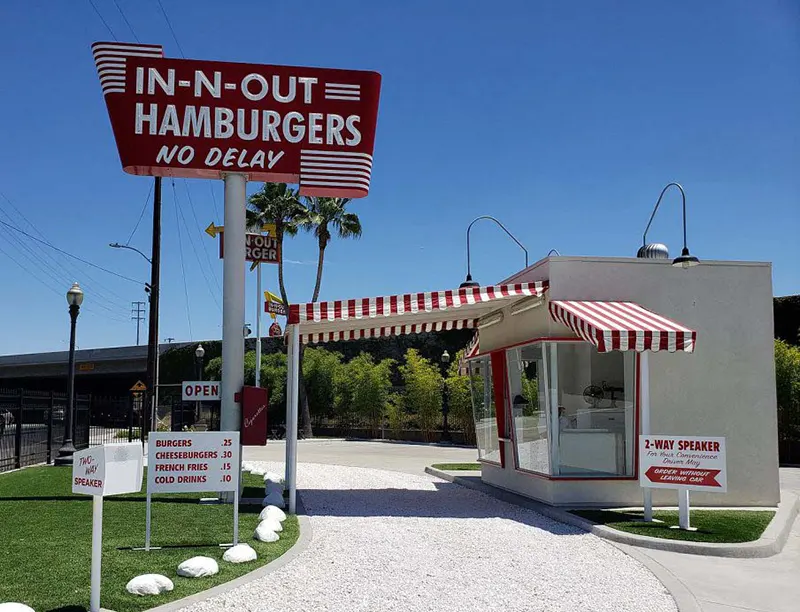
Replica of the Original In-N-Out Stand in Baldwin Park
In-N-Out Burger has chosen not to franchise its operations or go public; one reason is the prospect of food quality or customer consistency being compromised by excessively rapid business growth.
The In-N-Out restaurant chain has developed a highly loyal customer base and has been rated as one of the top fast-food restaurants in several customer satisfaction surveys.
KFC (1930)
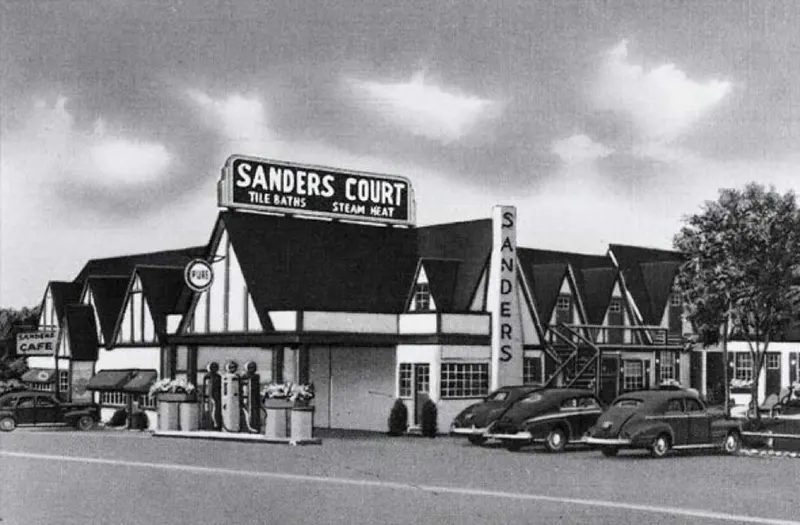
KFC (1930)
Harland Sanders, a retired chef and entrepreneur, started serving his signature fried chicken recipe to travelers at his gas station in the 1930s.
The moniker “Kentucky Fried Chicken” was chosen as a homage to the state where Sanders honed his culinary skills and perfected his secret blend of 11 herbs and spices.
The colonel’s fried chicken quickly gained popularity for its unique flavor and preparation. Using a pressure cooker, Sanders achieved a crisp and flavorful crust while keeping the meat tender and juicy—a method that set his chicken apart from others.
In 1952, the first official KFC franchise was established, marking the transition from a humble gas station eatery to a fast-food franchise empire.
KFC’s original product is pressure-fried chicken pieces, seasoned with Sanders’ signature recipe of “11 herbs and spices”. The constituents of the recipe are a trade secret.
Larger portions of fried chicken are served in a cardboard “bucket”, which has become a feature of the chain since it was first introduced by franchisee Pete Harman in 1957.
Krispy Kreme (1937)
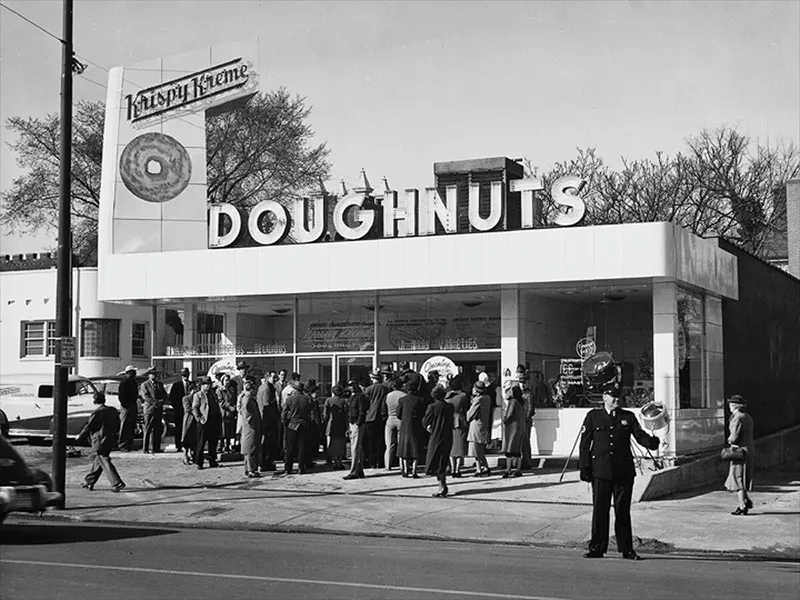
Krispy Kreme (1937)
In the heart of Winston-Salem, North Carolina, in 1937, Krispy Kreme emerged as a small doughnut shop with big dreams.
Krispy Kreme’s name is a testament to its mission of crafting doughnuts that are, quite literally, crispy and creamy.
The pairing of “Krispy” with “Kreme” forms a charming play on words that hints at the doughnuts’ light, airy texture and the indulgent experience they promise.
The brand’s founder, Vernon Rudolph, began his doughnut-making journey in the late 1930s, inspired by a secret recipe he had acquired.
The original Krispy Kreme doughnuts quickly earned a reputation for their melt-in-your-mouth goodness, and the small shop became a local sensation.
Steady growth preceded an ambitious expansion as a public company in the period 2000 to 2016, which ultimately proved unprofitable.
In 2016, the company returned to private ownership and in July 2021, Krispy Kreme became publicly traded again on the Nasdaq.
McDonald’s (1948)
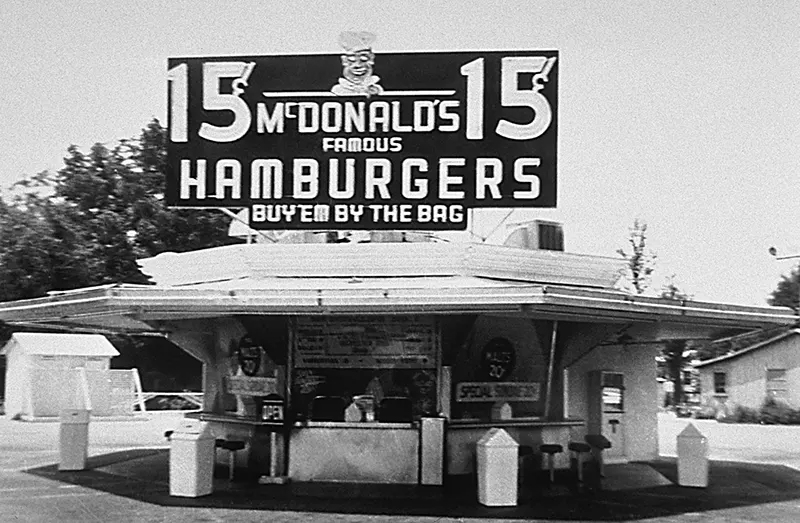
McDonald’s (1948)
In 1948, a small drive-in restaurant named McDonald’s opened its doors in San Bernardino, California, setting in motion a transformation that would forever reshape the fast-food landscape.
The name “McDonald’s” carries a simplicity that mirrors the brand’s initial focus on delivering quick, consistent, and affordable meals.
The restaurant’s moniker was derived from the names of its founders, Richard and Maurice McDonald. The McDonald brothers’ innovation extended beyond the name.
They introduced the “Speedee Service System,” which emphasized a streamlined production process that allowed them to serve consistent, delicious meals in record time. This approach laid the groundwork for the future of fast-food service.
In 1955, entrepreneur Ray Kroc joined the McDonald brothers, taking their concept to a national and eventually global scale.
The principles of efficiency, affordability, and consistency remained at the heart of McDonald’s identity as it expanded. The brand’s golden arches, introduced in the 1960s, became iconic symbols of McDonald’s.
Pizza Hut (1958)

The original Pizza Hut. Located on the Wichita State University campus
Pizza Hut was launched on May 31, 1958, by two brothers, Dan and Frank Carney, both Wichita State students, as a single location in Wichita, Kansas.
“The building had a sign that would only accommodate nine characters. The brothers wanted to use ‘Pizza’ in the name and that left room for only three more letters. A family member suggested that the building looked like a hut—and Pizza Hut was born.”
Pizza Hut introduced a novel concept: pizza that could be enjoyed beyond the confines of Italian restaurants. Their pioneering approach to delivery and dine-in options set the stage for the evolution of fast-casual dining.
The brand’s signature red roof, introduced in the 1960s, became a symbol of the welcoming atmosphere that awaited pizza lovers.
Popeyes (1972)
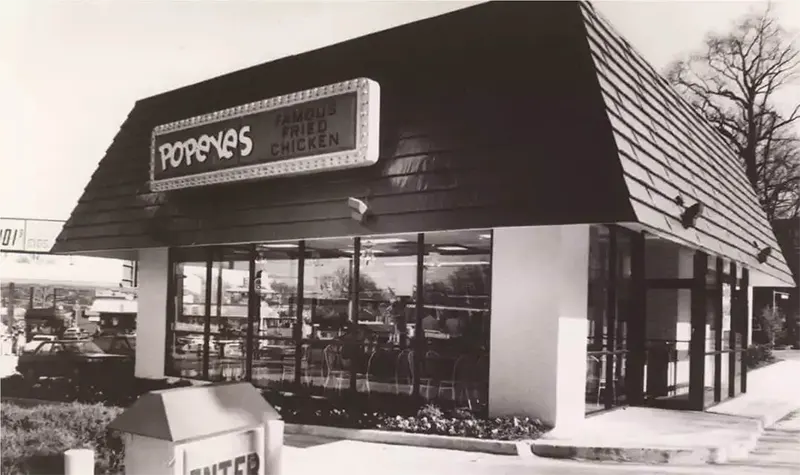
Popeyes (1872)
Popeyes was formed in Arabi, Louisiana, a suburb of New Orleans, Louisiana, in St. Bernard Parish. It first opened its doors on June 12, 1972, as “Chicken on the Run”.
Owner Al Copeland wanted to compete with Kentucky Fried Chicken, but his restaurant failed after several months.
Copeland reopened the restaurant four days later as Popeyes Mighty Good Chicken. By 1975, the company had been renamed as Popeyes Famous Fried Chicken.
The name “Popeyes” draws its inspiration from the classic character Popeye the Sailor, known for his love of spinach and strength.
In a similar vein, Copeland aimed to create a restaurant that would be known for its robust and hearty offerings.
Sonic Drive-In (1953)

Sonic Drive-In (1953
In 1953, a new dining concept known as Sonic Drive-In debuted, bringing a novel approach to fast food.
The name “Sonic” reflects the brand’s emphasis on speed and service, encapsulating its innovative idea of delivering food directly to customers in their cars.
Shawnee, Oklahoma, circa 1953, was the home of the first-ever Sonic Drive-In location, which was originally dubbed the Top Hat Drive-In.
Founder Troy N. Smith’s vision was to create a unique dining experience that combined the convenience of drive-in service with a diverse menu of freshly made food items.
The introduction of carhops—servers on roller skates—added a distinct touch to Sonic’s identity. The distinctive architecture of Sonic Drive-In locations, characterized by colorful canopies and outdoor seating, further solidified the brand’s image.
Subway (1965)

Subway (1965)
In 1965, Fred DeLuca borrowed $1,000 from friend Peter Buck to start “Pete’s Drive-In: Super Submarines” at 3851 Main Street in Bridgeport, Connecticut, and in the following year, they formed Doctor’s Associates Inc. to oversee operations of the restaurants as the franchise expanded.
The holding company derives its name from DeLuca’s goal to earn enough from the business to pay tuition for medical school, as well as Buck’s having a doctorate in physics. In 1968, the sandwich shop was renamed “Subway”.
Taco Bell (1954)

Taco Bell (1954)
Taco Bell was founded by Glen Bell, an entrepreneur who first opened a hot dog stand called Bell’s Drive-In in San Bernardino, California, in 1948.
Bell watched long lines of customers at a Mexican restaurant called the Mitla Cafe, located across the street, which became famous among residents for its hard-shelled tacos.
Bell attempted to reverse-engineer the recipe, and eventually, the owners allowed him to see how the tacos were made.
He took what he had learned and opened a new stand in 1951. The name underwent several changes, from Taco-Tia through El Taco, before settling on Taco Bell.
Wendy’s (1969)
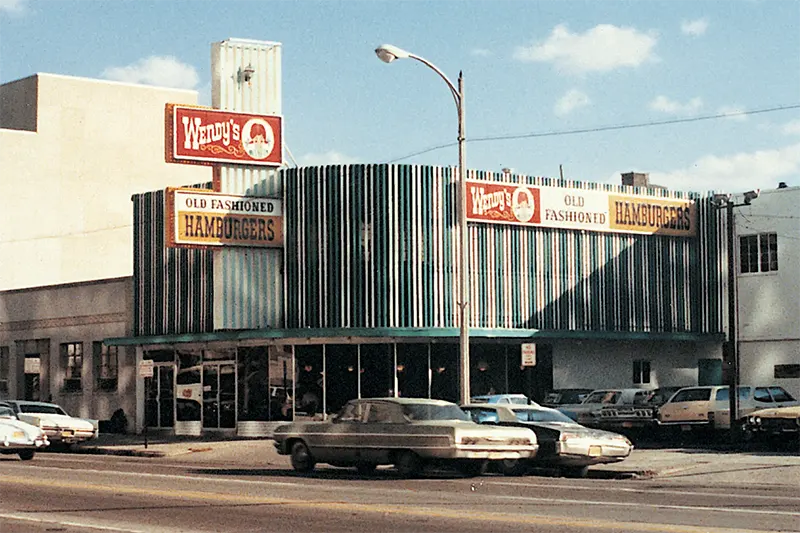
Wendy’s (1969)
Wendy’s “old-fashioned” hamburgers were inspired by Dave Thomas’s trips to Kewpee Hamburgers in his hometown of Kalamazoo, Michigan.
Kewpee sold square hamburgers and thick malt shakes. Thomas founded Wendy’s in Columbus, Ohio, in 1969 and featured square patties with corners that stuck out from the sides of the circular bun, giving the impression of an abundance of good quality meat.
Thomas named the restaurant after his fourth child Melinda Lou “Wendy” Thomas. Photographs of her were on display at the original Wendy’s restaurant until it closed.
In his autobiography, Thomas wrote that he regretted naming the restaurant after his daughter because once it became a fast food empire she “lost some of her privacy” with many people assuming she was the official company spokesperson.
Whataburger (1950)
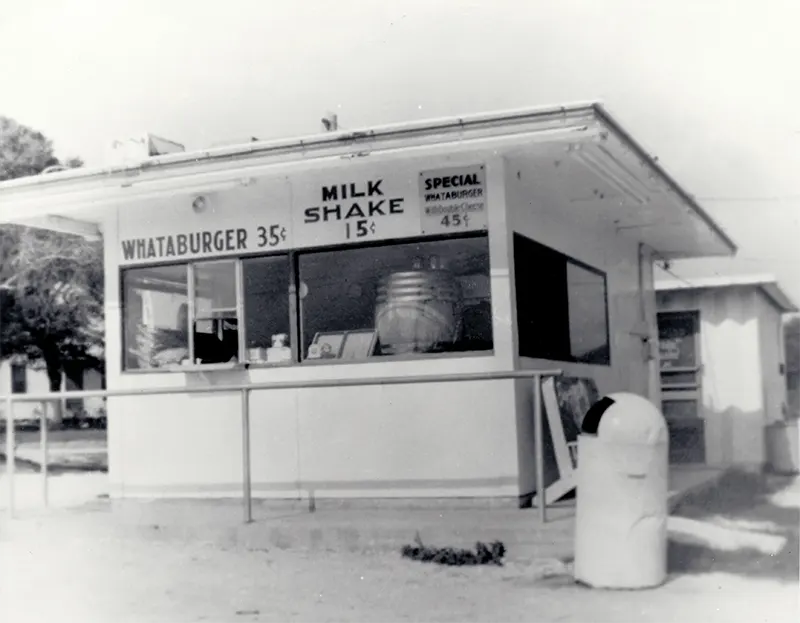
Whataburger (1950)
The brainchild of Harmon Dobson and Paul Burton, Whataburger opened its doors in Corpus Christi, Texas. The founders were not content with the run-of-the-mill fast-food offerings of the time.
They envisioned a place where hungry patrons could sink their teeth into a truly remarkable burger – one that would make them exclaim “What a burger!” in sheer delight.
After Dobson invented the original five-inch burger—which was a whole inch larger than other fast food burgers at the time—the speedy selling rate proved the burgers lived up to their name.
Whataburger was known for many years for its distinct A-framed orange-and-white-stripe-roofed buildings. The first A-frame restaurant, the 24th Whataburger to open, was built in Odessa, Texas in 1961.
Although the company highlighted the restaurant as an unofficial historical landmark, it was demolished in 2019 and replaced by a new building.
White Castle (1921)

White Castle (1921)
Founded on September 13, 1921, in Wichita, Kansas, by Walter A. Anderson and Billy Ingram, it has been generally credited as the world’s first fast-food hamburger chain. It is known for its small, square hamburgers referred to as “sliders”.
Billy came up with the name: White for cleanliness and Castle for permanence and strength, and the building was made to look like a small white castle. Porcelain was used on the interior to emphasize a sparkling clean all-white restaurant.
The burgers were initially priced at five cents until 1929 and remained at 10 cents until 1949.
In the 1940s, White Castle periodically ran promotional ads in local newspapers that contained coupons offering five burgers for ten cents, takeout only.
To invoke a feeling of cleanliness, their restaurants were small buildings with stainless steel interiors, and employees outfitted with spotless uniforms.
Their first restaurants in Wichita were a success, and the company branched out into other Midwestern markets, starting in 1922 with El Dorado, Kansas.
(Photo credit: Wikimedia Commons / Flickr / Pinterest).

